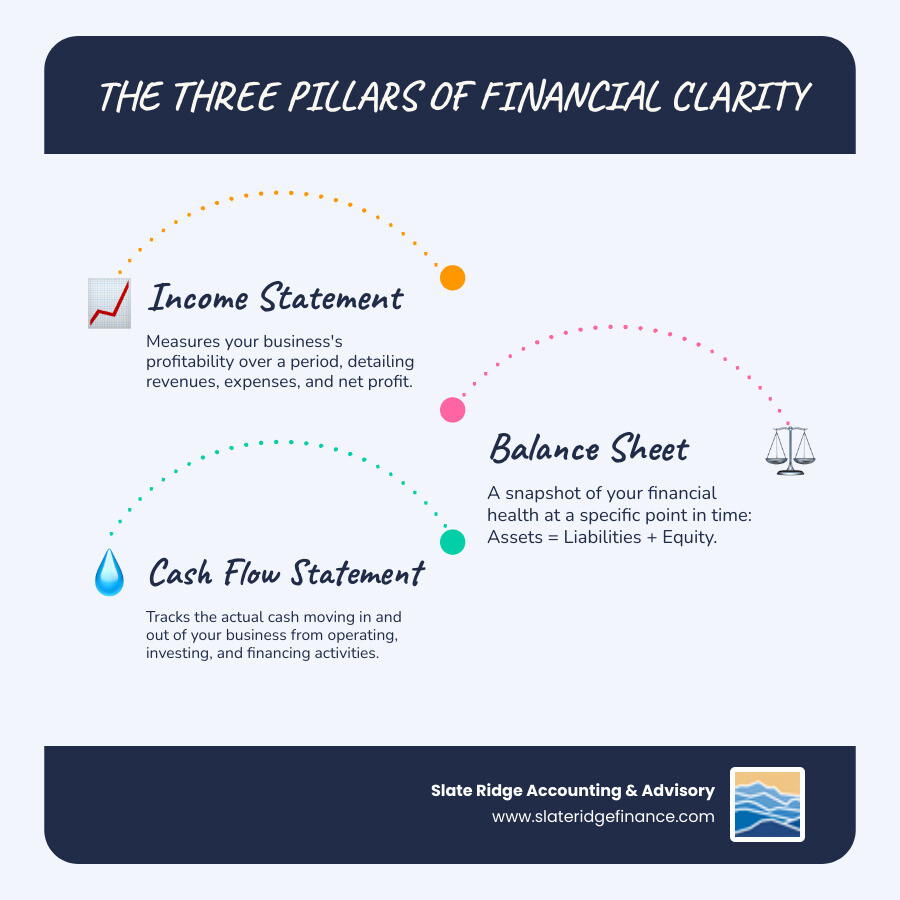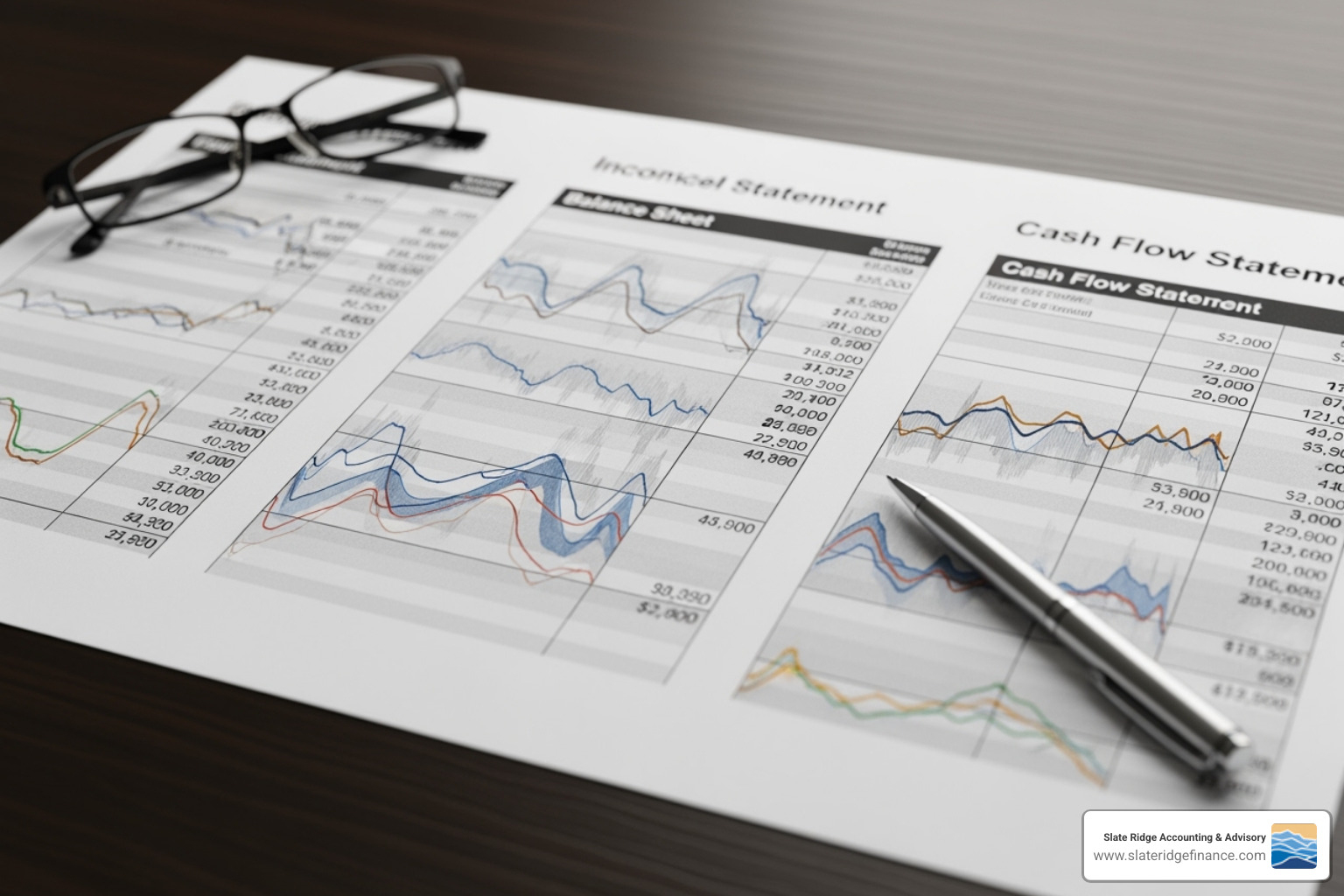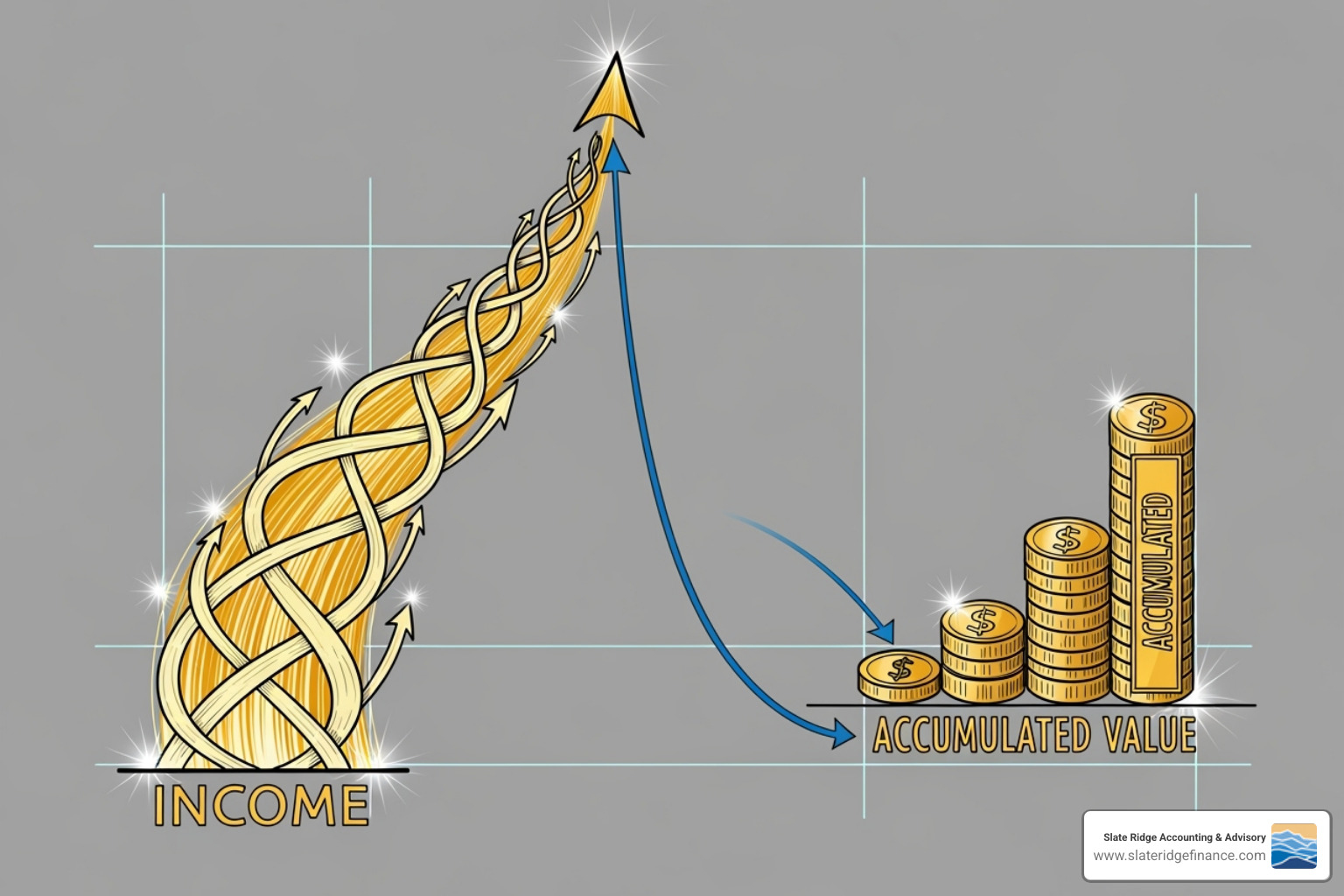Why Small Business Financial Reporting is Your Path to Success
Small business financial reporting involves creating and analyzing financial statements that track your company's income, expenses, assets, and cash flow. This process is crucial for making informed business decisions.
Essential Financial Reports:
- Income Statement - Shows revenue, expenses, and profit over a period
- Balance Sheet - Displays assets, liabilities, and equity at a point in time
- Cash Flow Statement - Tracks money flowing in and out of your business
- Additional Reports - Accounts receivable aging, budget vs. actual, and financial ratios
Key Benefits:
- Make data-driven decisions
- Spot trends and problems early
- Secure funding from lenders and investors
- Stay compliant with tax and legal requirements
The numbers tell a sobering story: 59% of small businesses say they are in fair or poor financial condition, and 85% have experienced some sort of financial difficulty. The good news is that businesses that understand their financial reports are far more likely to thrive.
Think of financial reporting as your business's GPS. Without it, you're driving blind. With it, you can see where you are, where you're headed, and when to change course. While many owners feel overwhelmed by accounting jargon, financial reporting doesn't have to be complicated. The key is knowing which reports matter and how to read them to improve cash flow, plan for growth, or simply understand if your business is profitable.

Simple guide to Small business financial reporting:
Why Financial Reporting is Your Business's GPS
Running a business without small business financial reporting is like navigating blind. The reality is sobering: 59% of small businesses say they are in fair or poor condition. Many of these struggles stem from a lack of financial visibility. When you can't see where your money is coming from or going, every decision is a gamble.
Financial reports are your business's GPS, helping you plan the best route to your goals. They enable:
- Strategic planning: Use real data on revenue trends and expenses to decide whether you can afford a new employee or equipment.
- Risk mitigation: Reports act like dashboard warning lights, alerting you to problems like declining margins before they become disasters.
- Stakeholder confidence: Banks and investors have more confidence when they see you understand your numbers.
- Performance clarity: You'll finally know which products or services are your real money-makers. Our bookkeeping service for small business can help establish these crucial reporting systems.
The Benefits of Regular Reporting
Regular reporting transforms your business from reactive to proactive, helping you catch problems when they're still fixable.
- Data-driven decisions: Replace guesswork with facts. Reports show if you have the cash flow and margins to support growth. Research confirms accurate financial reporting leads to better decision-making.
- Identifying trends: Reviewing reports monthly helps you spot seasonal patterns, allowing you to plan inventory, manage cash flow, and time decisions.
- Securing funding: Lenders and investors want to see businesses that understand their profitability. Clean financial statements signal you're a safe bet.
- Improving operational efficiency: See exactly where every dollar goes. One restaurant owner found through their reports that inconsistent portions, not ingredient prices, were driving up food costs, saving them thousands annually.
- Legal compliance: Regular reporting makes tax time less stressful. You're always ready for audits, tax filings, and regulatory requirements.
Understanding Your Key Performance Indicators (KPIs)
KPIs are like gauges on your dashboard, offering instant insight into specific parts of your business.
- Profit margins show if your pricing and costs are effective.
- Return on investment (ROI) reveals if your marketing campaigns or equipment purchases are actually paying off.
- Cash flow ratios are crucial for telling you if you can cover your bills next month.
- Customer acquisition cost helps you determine if your growth strategies are sustainable.
Tracking these KPIs allows you to make small adjustments that lead to big improvements. For more on this, explore our guide on business growth strategies.
The Three Pillars of Financial Clarity: Core Statements Explained

The three core statements of small business financial reporting give you a complete picture of your business. They are built on principles like using recorded facts and consistent accounting conventions to ensure the information is reliable.
The Balance Sheet: A Snapshot of Your Financial Health
The Balance Sheet is a snapshot of your business's financial position at a single moment in time. It shows what you own, what you owe, and what's left, all based on this simple equation:
Assets = Liabilities + Equity
- Assets: Everything your business owns that has value (cash, inventory, equipment).
- Liabilities: Everything your business owes to others (loans, unpaid bills).
- Equity: The owner's stake in the company (Assets - Liabilities).
A healthy Balance Sheet shows if your business can pay its bills, indicating its solvency. You can download a balance sheet template to start. For help setting up your accounts, see our guide on accounts for small business.
The Income Statement: Measuring Your Profitability
The Income Statement shows your business's financial performance over a period, like a month or a quarter. It tells you if you made a profit by subtracting expenses from revenue.
It starts with revenue and subtracts the Cost of Goods Sold (COGS) to find your gross profit. Then, it subtracts other operating expenses (like rent and salaries) to determine your net income—the bottom line. This statement reveals if your core operations are profitable and helps you spot trends. You can get started with an income statement template.
The Cash Flow Statement: Tracking the Lifeblood of Your Business
A business can be profitable on paper but still run out of cash. The Cash Flow Statement is critical because it tracks the actual cash moving in and out of your bank account. It breaks cash movement into three categories:
- Operating activities: Cash from day-to-day business operations.
- Investing activities: Cash used for or generated from buying/selling assets like equipment.
- Financing activities: Cash from loans, investors, or owner contributions.
Positive cash flow from operations is a healthy sign. This statement keeps you grounded in the reality of your cash position. Download a cash flow statement template to begin.
How Statements Work Together & Reports Beyond the Big Three

These three statements are interconnected. For example, net income from the Income Statement flows into the equity section of the Balance Sheet. Beyond the big three, other reports offer deeper insights:
- Accounts Receivable Aging Report: Shows who owes you money and for how long.
- Accounts Payable Aging Report: Shows who you owe money to, helping you manage payments.
- Budget vs. Actual Report: Compares your financial plan to your actual results, highlighting variances.
- 13-Week Cash Forecast: Projects cash needs for the next three months, which is vital for managing growth.
For more on managing cash flow, see our guide on small business accounts receivable and payable. When you're ready to plan, check out our article on business financial forecasting.
Mastering Small Business Financial Reporting: Best Practices and Tools

Mastering small business financial reporting comes down to three principles: consistency, accuracy, and automation. Getting these right transforms reporting from a chore into a powerful business tool.
Choosing Your Method: Cash vs. Accrual Accounting
You must first decide how to track your money. Cash accounting is simpler: you record income and expenses when money changes hands. It works well for small, service-based businesses without inventory.
Accrual accounting records revenue when earned and expenses when incurred, regardless of when cash is exchanged. It's more complex but gives a truer picture of financial health, which is why it's preferred by growing businesses and lenders.
| Feature | Cash Basis Accounting | Accrual Basis Accounting |
|---|---|---|
| Timing of Revenue | Recorded when cash is received | Recorded when it is earned, regardless of cash receipt |
| Timing of Expenses | Recorded when cash is paid | Recorded when they are incurred, regardless of cash payment |
| Complexity | Simpler, often used by very small businesses | More complex, provides a clearer picture of long-term financial health |
| Business Suitability | Best for businesses with simple transactions, no inventory | Best for growing businesses, with inventory, or seeking financing |
| GAAP Compliance | Not GAAP-compliant | Generally Accepted Accounting Principles (GAAP)-compliant |
The accrual method aligns with GAAP (Generally Accepted Accounting Principles), the gold standard for financial reporting. Using it builds credibility, even if not legally required. The methods also have different tax implications, so choose based on your business size and complexity.
Leveraging Technology for Smarter Small Business Financial Reporting
Manual reporting with spreadsheets is inefficient. Cloud accounting software has revolutionized small business finance, offering access to your data from anywhere. 70% of SMBs say their next platform will be cloud-based because it provides real-time data, automatic backups, and seamless collaboration.
Automation is the next step. Imagine bank transactions categorizing themselves and reports updating in real-time. Gartner predicts that by 2027, 90% of financial analytics will be automated, freeing you to focus on analysis, not data entry. Our cloud accounting services help businesses leverage this technology for easier decision-making.
Common Mistakes and Red Flags to Avoid
Avoid these common, costly mistakes:
- Inaccurate data entry: The "garbage in, garbage out" principle means incorrect entries lead to useless reports.
- Not reconciling accounts: Regularly match your records to your bank statements to ensure accuracy.
- Mixing personal and business finances: This creates a mess for tracking and taxes. Open a separate business bank account.
- Ignoring your reports: Your reports are only valuable if you read and act on them.
Watch for these red flags:
- Rising debt-to-equity ratio: This indicates over-reliance on borrowed money.
- Consistently declining revenue: A steady downward trend signals a serious problem.
- Negative cash flow from operations: If your core business isn't generating cash, you have a fundamental problem that needs to be fixed immediately.
When to Call in the Pros and Ensure Compliance
As your business grows, handling your own financial reporting may no longer make sense. It's time to get help if you face an overwhelming workload or complex transactions like multi-state sales tax.
Professionally prepared statements are essential for seeking funding or facing an audit. A professional can also help with tax planning. A bookkeeper handles daily transactions, while a CPA (Certified Public Accountant) provides strategic advice and tax planning. Adhering to GAAP standards, maintained by the Financial Accounting Standards Board (FASB), builds credibility with stakeholders.
Our virtual accounting services provide solutions that grow with your business, from basic bookkeeping to comprehensive advisory. Sometimes, the smartest decision is to delegate to an expert.
Frequently Asked Questions about Small Business Financial Reporting
How often should a small business prepare financial reports?
Monthly reviews are the gold standard for active business management. This frequency allows you to spot trends, catch problems early, and make timely adjustments. Quarterly and annual reports are also vital for strategic planning, tax preparation, and presenting to lenders or investors.
A good rhythm for most small businesses is to review the Income Statement and Cash Flow Statement monthly, with a deeper dive into all reports quarterly. The ideal frequency depends on your business's complexity and growth stage.
What are the consequences of poor financial reporting?
Poor small business financial reporting leads to serious negative consequences, including:
- Compromised decision-making: Without accurate data, every choice is a guess, leading to costly mistakes.
- Difficulty securing funding: Lenders and investors require reliable financial statements to assess your business's viability.
- Fines and penalties: Inaccurate reporting can lead to expensive fines for tax and regulatory non-compliance.
- Missed growth opportunities: You won't have the insights to know which products are most profitable or when to expand.
- Increased risk of business failure: A lack of financial visibility makes it difficult to steer challenges and can lead to closure.
How do financial reporting requirements differ by location?
Reporting requirements vary significantly by country, state, and business structure. In the United States, many businesses follow Generally Accepted Accounting Principles (GAAP), which lenders and investors prefer for its consistency. Many other countries use International Financial Reporting Standards (IFRS).
Additionally, local regulations for specific industries or regions may apply. Because compliance is complex and penalties for errors can be severe, it's crucial to consult a professional who understands the specific requirements for your business's location and industry.
Conclusion: Turn Financial Data into Your Growth Strategy
We've covered the essentials of small business financial reporting, from core statements and KPIs to best practices and technology. The key takeaway is that financial reporting isn't a chore—it's your secret weapon for growth. Successful owners don't just look at their reports; they use them to turn numbers into actionable insights that guide their next move.
Consistent and accurate reporting transforms gut feelings into data-driven confidence. It enables the proactive management that separates businesses that grow from those that stagnate. With clear financial visibility, you can spot opportunities, manage problems, and make decisions with confidence.
At Slate Ridge Accounting & Advisory, we've seen how transformative this can be. We are your partners in growth, offering a modern, cloud-based approach that provides real-time insights and personalized, industry-custom solutions. We help you set up reports, clean up messy books, or develop forecasting models, giving you the financial clarity needed to thrive.
Take control of your finances today and turn your financial data into a powerful growth strategy. When you're ready to transform your business finances, view our pricing and packages to see how we can help your business flourish.
Ready to get started?
Book a free consultation today and let’s explore how Slate Ridge can support your business with expert accounting that’s accurate, timely, and built around your goals.






